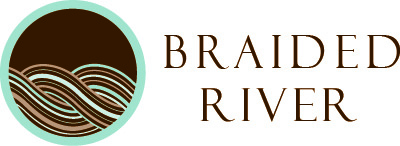By Jeff Fair
This blog is based on an essay from the book On Arctic Ground: Tracking Time through Alaska’s National Petroleum Reserve. The Western Arctic, also known as the NPR-A (National Petroleum Reserve-Alaska), is a fragile Arctic region, home to Indigenous communities and bountiful wildlife including caribou, fish and migratory birds, and is a critical carbon sink to help fight climate change. The Colville River is one of five designated Special Areas in the Western Arctic. Learn more about Special Areas in the Arctic here.
***
IF HAWK HEAVEN OCCURS ANYWHERE in the earth's Arctic expanse, it exists atop the bluffs and along the cliffs of the lower Colville River in the National Petroleum Reserve-Alaska. This phenomenal concentration in both diversity and density of nesting raptors-peregrine falcons, gyrfalcons, golden eagles, rough-legged hawks—is unique in the circumpolar Arctic. It was also a prime reason for the Colville River's inclusion in 1977 as one of the first four special areas established in the Reserve. More than a hundred pairs of Arctic peregrines nest along the Colville and its tributaries, a population that played a significant role in the recovery of this subspecies, which was delisted from endangered status in 1994.
Photo courtesy of Florian Schulz
The Colville River, the largest Arctic river in North America and fourth largest on earth with its entire watershed in the Arctic, drains most of the western Brooks Range. The Colville River Special Area (CRSA), less than 20 miles wide for much of its reach, follows the river corridor along more than 300 miles of riverine bends and covers a little over 2.4 million acres. Along the lower, north-flowing river stand the cliffs and high bluffs favored by raptors. These same bluffs expose sedimentary strata containing the world's most extensive polar-region collection of dinosaur and other fossils up to 100 million years old, making this a unique and important paleontology site.
The western extent of the CRSA covers the upper Colville and abuts the Utukok River Uplands Special Area to include part of the Western Arctic Caribou Herd's calving grounds. The entire Colville River, in its undisturbed state, provides a travel corridor for caribou and grizzly bears. Wolverines wander furtively throughout. A small but significant and rare population of Arctic moose depend upon the riparian vegetation and cover here. Wolf densities in parts of the corridor are higher than anywhere else on the coastal plain.
Photo courtesy of the Cornell Lab of Ornithology
Yellow-billed loons nest mostly from the lower Colville westward; black brant and greater white-fronted geese nest thickly on the Colville River delta, where the river fans out to meet the Beaufort Sea west of Prudhoe Bay. All three species are found within the lower, northern part of the CRSA, as are the threatened Steller's and spectacled eiders. Songbirds proliferate along the Colville among the greatest diversity of habitats on the North Slope. Fish runs on the lower Colville include sea-run pink and chum salmon, Arctic cisco, and other whitefish species. Grayling find their way into the smaller tributaries.
Intensive subsistence use of the CRSA, primarily and significantly by lnupiat from the village of Nuiqsut, near the river's mouth, includes the harvest of fish, caribou, waterfowl, and furbearers. The river corridor itself provided a traditional access route from the coastal plain all the way into the Brooks Range foothills.
The concentrated raptor populations, if not protected, would be vulnerable to industrial development (including large-scale excavation of riverine gravel to build drilling pads, roads, and other infrastructure) leading to habitat loss, nest abandonment, and negative effects on their prey base. Helicopter and fixed-wing aircraft traffic and noise are likely to disrupt raptor nesting and feeding behaviors. Industrial activity including human presence, truck traffic, and pipelines is likely to subvert caribou migration paths. Buffer zones along the river corridor and its tributaries would help protect raptor nesting and wildlife use of the Colville River. No-lease zones restricting all development are preferable in the caribou calving area upstream.
Photo courtesy of Florian Schulz
With no deep water port in the western Arctic, oil produced in the Reserve will have to cross the Colville River by pipeline to reach the Trans-Alaska Pipeline. Even small spills—the current system averages about one spill of several hundred gallons every day—could drift downstream to foul the Colville River delta, a unique and much-studied ecosystem just outside the Reserve known for its nesting black brant, white-fronted geese, yellow-billed loons, plus sixty-seven other nesting species and twenty-two overwintering fish species.
The entire Colville River has been proposed to be (and is considered eligible to become) a National Wild and Scenic River, as have its tributaries, the Nigu and Etivluk rivers, flowing out of the Brooks Range in the south-central Reserve. The latter carry two outstanding archaeological sites and exceptional river-running and backpacking potential in a scenic setting among Dall sheep, caribou, raptors, and grizzlies. Several national landmarks have been proposed within the CRSA.
Here beckons a rare opportunity to protect the spirit and ecology of a wild and pristine river corridor from source to sea delta, more than 300 miles long, in a gorgeous wilderness setting. The Colville could float an Arctic traveler by raft or canoe from the foothills of the continent's northernmost mountain range through its uplands, beneath the wings of falcons, hawks, and golden eagles, and on down to the Arctic Ocean's Beaufort Sea.
ABOUT THE AUTHOR
Jeff Fair is a loon biologist and award-winning writer who has lived and worked in Alaska for more than 30 years, including 16 trips in the Teshekpuk Lake area and two on the coastal plain of the Arctic National Wildlife Refuge. He co-authored a 2002 Audubon Alaska report on the National Petroleum Reserve–Alaska, and his fieldwork with yellow-billed loons in Arctic Alaska led to the species’ current “warranted but precluded” status for Endangered Species Act listing, making it a candidate species for future listing.



